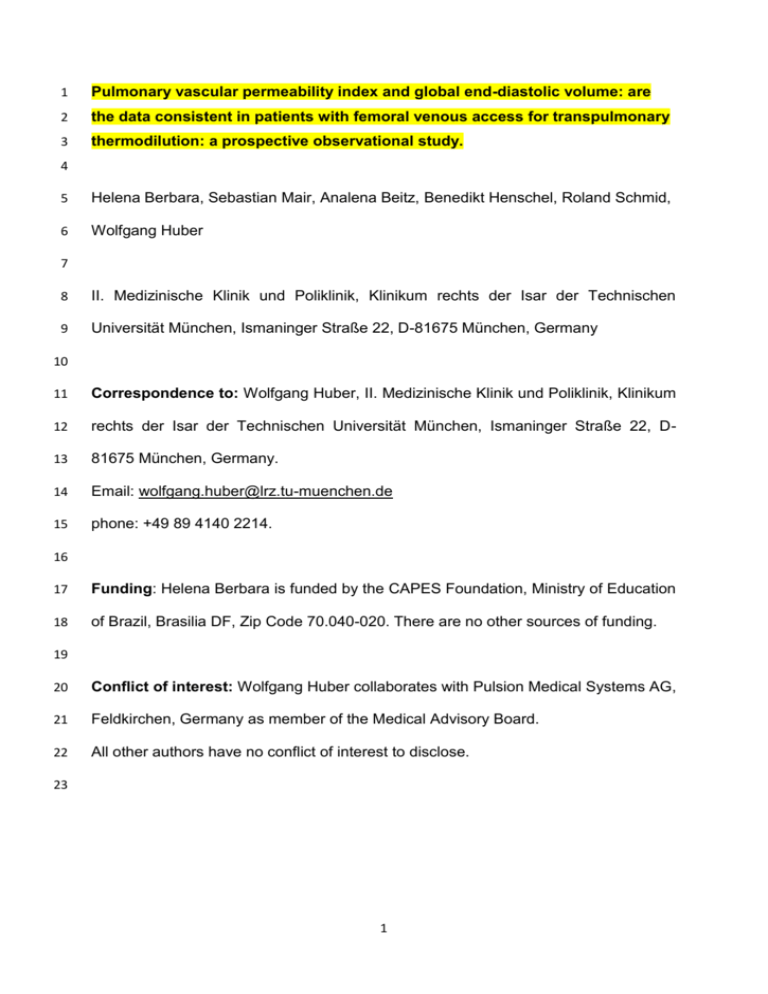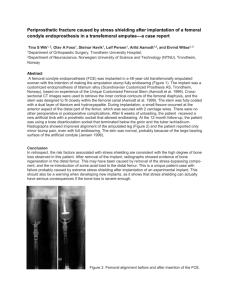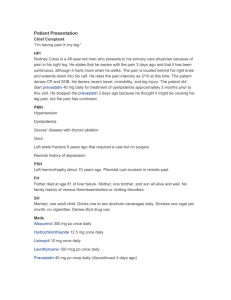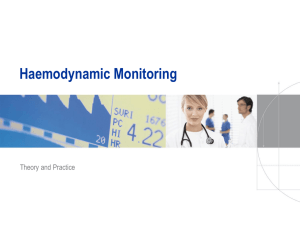Extravascular lung water
advertisement

1 Pulmonary vascular permeability index and global end-diastolic volume: are 2 the data consistent in patients with femoral venous access for transpulmonary 3 thermodilution: a prospective observational study. 4 5 Helena Berbara, Sebastian Mair, Analena Beitz, Benedikt Henschel, Roland Schmid, 6 Wolfgang Huber 7 8 II. Medizinische Klinik und Poliklinik, Klinikum rechts der Isar der Technischen 9 Universität München, Ismaninger Straße 22, D-81675 München, Germany 10 11 Correspondence to: Wolfgang Huber, II. Medizinische Klinik und Poliklinik, Klinikum 12 rechts der Isar der Technischen Universität München, Ismaninger Straße 22, D- 13 81675 München, Germany. 14 Email: wolfgang.huber@lrz.tu-muenchen.de 15 phone: +49 89 4140 2214. 16 17 Funding: Helena Berbara is funded by the CAPES Foundation, Ministry of Education 18 of Brazil, Brasilia DF, Zip Code 70.040-020. There are no other sources of funding. 19 20 Conflict of interest: Wolfgang Huber collaborates with Pulsion Medical Systems AG, 21 Feldkirchen, Germany as member of the Medical Advisory Board. 22 All other authors have no conflict of interest to disclose. 23 1 1 Abstract: 2 Background: Transpulmonary thermodilution (TPTD) derived parameters are widely 3 used to direct fluid management in ICU-patients. Extravascular lung water EVLW and 4 its ratio to pulmonary blood volume (pulmonary vascular permeability index PVPI) 5 have been associated with mortality. In single indicator TPTD pulmonary blood 6 volume (PBV) is estimated to be 25% of global end-diastolic volume (GEDV). A 7 recent study demonstrated marked overestimation of GEDV indexed to body-surface 8 area (BSA; GEDVI) when using a femoral central venous catheter (CVC) for indicator 9 injection due to the additional volume measured in the vena cava inferior. Therefore, 10 a correction formula derived from femoral TPTD and biometric data has been 11 suggested. As a consequence, one of the commercially available TPTD-devices 12 (PiCCO; Pulsion Medical Systems, Germany) requires information about CVC site 13 (femoral or jugular/subclavian). Correction of GEDVI in case of femoral injection can 14 be assumed. However, there is no data if correction also pertains to unindexed 15 GEDV, which is used for calculation of PBV and PVPI. Therefore, we investigated, if 16 also GEDV, PBV and PVPI are corrected by the new PiCCO-algorithm. 17 Methods: In this prospective observational study 110 triplicate TPTDs were 18 performed within 30 hours in 11 adult ICU patients with PiCCO-monitoring and 19 femoral CVC. We analyzed if the femoral TPTD correction formula for GEDVI was 20 also applied to correct GEDV. In a second step we compared PVPIdisplayed to 21 PVPIcalculated which was calculated as EVLW displayed/(0.25*GEDVdisplayed). 22 Results: Multiplication of GEDVIdisplayed by BSA resulted in GEDVcalculated which was 23 not significantly different to GEDVdisplayed (1459+365 mL vs. 1459+366mL) suggesting 24 that correction for femoral indicator injection also pertains to GEDVdisplayed. However, 25 PVPIdisplayed was significantly lower than PVPIcalculated (1.64+0.57 vs. 2.27+0.72; 2 1 p<0.001). In addition to a bias of -0.64+0.22 there was a percentage error of 22%. 2 Application of the correction formula suggested for GEDVI to PVPI displayed reduced the 3 bias of PVPIdisplayed compared to EVLW/PBV from -0.64+0.22 to -0.10+0.05 and the 4 percentage error from 22% to 4%. 5 Conclusions: Correction for femoral venous catheter site in the PiCCO-device 6 pertains to both GEDVIdisplayed and GEDVdisplayed, but not to PVPIdisplayed. To provide 7 consistent hemodynamic information, PVPI should be calculated based on 8 GEDVcorrected in case of femoral CVC. 9 10 Key words: 11 Lung edema 12 ARDS 13 Extravascular lung water 14 Pulmonary vascular permeability index 15 Transpulmonary thermodilution 16 Femoral venous catheter 17 Hemodynamic monitoring 18 Cardiac output 19 Catheter site 20 PiCCO 21 3 1 Introduction: 2 Appropriate fluid supply is a cornerstone of critical care. In addition to cardiac output 3 CO, transpulmonary thermodilution (TPTD) provides extravascular lung water 4 (EVLW) reflecting pulmonary edema and the preload parameter global end-diastolic 5 volume (GEDV) [1-6]. Increased EVLW is associated to mortality [3, 7-11]. GEDV and its 6 changes are associated to CO [6] and algorithms based on GEDV have been shown 7 to improve outcome [12]. Moreover, the relation of EVLW and pulmonary blood 8 volume (PBV) might be useful to differentiate the etiology of pulmonary edema [13, 14]. 9 PBV can be determined using double-indicator TPTD technique [13]. Single indicator 10 TPTD is much more common in clinical routine and estimates PBV as about 25% of 11 GEDV [14]. EVLW/PBV-ratio has been termed pulmonary vascular permeability index 12 “PVPI”. Several studies demonstrated that higher values of PVPI are associated to 13 pulmonary edema with increased permeability of the alveolo-capillary barrier [14]. 14 Increased PVPI has been found in patients with ARDS resulting from pulmonary (e.g. 15 pneumonia) or secondary (e.g. sepsis) pulmonary impairment. By contrast 16 hydrostatic pulmonary edema due to congestive heart failure usually does not result 17 in marked increases of PVPI since EVLW and PBV are increased to a similar extent 18 [13, 14]. 19 Although TPTD has become part of clinical routine, several pitfalls have to be kept in 20 mind. Two recent studies demonstrated marked overestimation of GEDV in case of 21 performing TPTD indicator injection using a femoral venous access due to the 22 additional volume of vena cava inferior (VCI) participating in TPTD [15, 16]; Fig. 1). 23 Figure 1 24 The authors suggested a correction formula for GEDV indexed to predicted body 25 surface area (GEDVI) based on data derived from femoral TPTD and biometric 4 1 information. As a consequence of these data one the manufacturer of the PiCCO 2 device (Pulsion Medical Systems, Feldkirchen, Germany) implemented a new 3 software requiring the information about CVC site (femoral or jugular/subclavian) and 4 correcting GEDVI in case of femoral injection. Although jugular and subclavian vein 5 access might be the preferred sites for CVC insertion, several recent studies on 6 catheter related bloodstream infections have demonstrated that femoral venous 7 access was used in about 20 to 35% of all catheter insertions [17, 18]. Therefore, 8 results of TPTD might be substantially altered in about one third of cases without 9 appropriate correction. 10 To the best of our knowledge there are no data available if the new PiCCO algorithm 11 also corrects unindexed GEDV and PVPI in case of femoral CVC. 12 Furthermore, data on PVPI were not investigated in both previous papers on TPTD 13 using a femoral CVC [15, 16]. 14 Therefore, it was the aim of our study to investigate if in case of femoral indicator 15 injection 16 - GEDV in the new PiCCO algorithm is given based on the correction of GEDVI and 17 - PVPI is based on corrected GEDV and corrected pulmonary blood volume. 18 19 Material and methods 20 The study was approved by the institutional review board. All patients or their legal 21 representatives gave written informed consent. 22 23 We prospectively performed 110 TPTDs in 11 patients with femoral indicator 24 injection. Ten triplicate TPTDs per patient were performed with 15mL cold saline 25 within a total of 30h. TPTD was performed as described previously using the PiCCO5 1 2 device (Pulsion Medical Systems, Feldkirchen, Germany) [6, 16, 19] and a 5-lumen 2 CVC (Multicath 5; Vygon; Aachen, Germany). All PiCCO-2 devices were equipped 3 with the V3.1 algorithm requiring information about the venous catheter site which 4 was set to “femoral” CVC in all patients. 5 6 Immediately after triplicate TPTD absolute and indexed mean values were 7 documented for CO, CI, GEDV, GEDVI, EVLW, EVLWI and PVPI as displayed by the 8 device. Parameters displayed by the device were subscripted with “displayed” (see 9 Table 1). 10 Table 1. 11 The main purpose of the study was to investigate the consistency of displayed values 12 by comparing displayed data (e.g. GEDVdisplayed, PVPIdisplayed) to the corresponding 13 values derived from calculation specified with the subscript “calculated” 14 (GEDVcaculated, PVPIcalculated). 15 If displayed and calculated values were inconsistent, we investigated whether the 16 inconsistency could be explained by (non-) application of the recently suggested 17 correction formula for the displayed values parameters [16]. In this case “ex post” 18 correction by our formula should result in a consistency of the “corrected” values 19 (with the subscript “corrected”) and the calculated values. 20 21 To analyze if the femoral TPTD correction formula for GEDVIdisplayed was only applied 22 for GEDVIdisplayed or if also GEDVdisplayed is corrected in case of femoral indicator 23 injection, we calculated GEDVcalculated using the formula 24 GEDVcalculated = GEDVIdisplayed*BSApredicted. 25 Finally, GEDVdisplayed was compared to GEDVcalculated. 6 1 In a second step we analyzed, if PVPIdisplayed is calculated based on a GEDVdisplayed 2 corrected for femoral indicator injection. Therefore, we compared PVPIdisplayed to 3 PVPIcalculated using the formula PVPIcalculated = EVLW displayed/(0.25 * GEDVdisplayed). 4 5 Predicted bodyweight BW predicted was calculated using the formula 6 Predicted bodyweight BW predicted [kg]: 7 Male: 50 + 0.91 * (height – 152.4) Female: 45.5 + 0.91 * (height – 152.4) 8 Predicted body surface area BSApredicted was calculated using BWpredicted instead of 9 actual bodyweight in the Dubois formula 10 BSADubois [m2] = 0.007184*weight [kg]0.425*height [cm]0.725 11 The correction formula suggested for correction of uncorrected femoral indicator 12 injection derived GEDVuncorrected is 13 GEDVIcorrected [mL / m2] = 0.539 * GEDVIuncorrected - 15.17 + 24.49 * CIuncorrected +2.311* 14 BW ideal [16]. 15 Ideal bodyweight BW ideal was calculated using the formula 16 Ideal bodyweight BW ideal [kg]: 17 Male: (height – 100) x 0.9 Female: (height – 100) x 0.85 18 19 Correlation of GEDVcalculated and GEDVIdisplayed was analyzed using Spearman 20 correlation. Comparisons of GEDVdisplayed vs. GEDVcalculated, PVPIdisplayed vs. 21 PVPIcalculated and PVPIcorrected vs. PVPIcalculated were performed using Wilcoxon-test for 22 paired samples, respectively. Bland-Altman analyses and calculation of percentage 23 error (PE) were used for these comparisons as described previously [20, 24 Altman analyses were corrected for repeated measurements allowing variability of 25 true values within each subject [22]. 7 21]. Bland- 1 All analyses were performed using IBM SPSS Statistics 21 (SPSS inc., Chicago, IL, 2 USA). 3 4 5 8 1 Results 2 Patients characteristics 3 Five female and six male patients were included. Patients characteristics are shown 4 in Table 2. 5 6 Table 2 7 8 GEDVcalculated was obtained by multiplying GEDVIdisplayed by BSApredicted. As 9 demonstrated in Figure 2 GEDVcalculated and GEDVdisplayed significantly correlated 10 (r2=1.0; p<0.001) and were not significantly different (1459+365 mL vs. 11 1459+366mL). 12 Figure 2 13 This confirms that correction for femoral venous catheter site pertains to both 14 GEDVIdisplayed and GEDVdisplayed. 15 Consequently, calculation of PVPIcalculated based on EVLW displayed and GEDVdisplayed 16 should result in a PVPIcalculated identical with PVPIdisplayed. 17 However, PVPIdisplayed was significantly lower than PVPIcalculated (Fig. 3; 1.64+0.57 vs. 18 2.27+0.72; p<0.001). 19 20 Figure 3 21 22 23 In addition to a bias of -0.64+0.22 Bland-Altman analysis demonstrated a percentage 24 error of 22% and upper and lower limits of agreement of -0.199 and -1.075 (Fig. 4). 25 This could be explained if instead of the corrected GEDVdisplayed an uncorrected 26 GEDVuncorrected was used for calculation of PBV and PVPIdisplayed. 9 1 Based on this hypothesis and also assuming that the formula for femoral indicator 2 injection suggested by our group is used by the latest PiCCO algorithm we 3 determined PVPIcorrected by multiplying PVPIcalculated by the ratio 4 GEDVuncorrected/GEDVdisplayed. 5 As shown in Figure 5 the bias of PVPIdisplayed.d to EVLW/PBV could be reduced from - 6 0.64+0.22 to -0.10+0.05. Furthermore, percentage error decreased from 22% to 4% 7 with upper and lower limits of agreement of -0.009 and -0.190 (Fig. 5). 8 9 Figure 5 10 11 Discussion 12 13 Despite improving outcome by a number of specific and unspecific approaches such 14 as low tidal volume [23], extracorporeal lung assist [24] and prone positioning [25] 15 ARDS still carries a high mortality of up to 65% [23-26]. Well balanced fluid 16 management providing appropriate resuscitation [27] as well as avoiding fluid 17 overload - particularly of the lungs - is another obvious approach to improve outcome 18 in ARDS. EVLW has been validated as a significant predictor of outcome in ARDS [3, 19 7-11]. 20 derives from inflammatory capillary leakage of the lungs or from general fluid 21 overload and congestive heart failure. Relating EVLW to pulmonary blood volume, 22 PVPI has been demonstrated to discriminate inflammatory from congestive 23 pulmonary failure [13, 14]. Therefore, combined use of EVLW and PVPI has been 24 suggested to specify therapy in acute pulmonary failure. However, there are a 25 number of studies suggesting pitfalls in using these parameters derived from TPTD: 26 Due to its current indexation solely to bodyweight EVLWI might be inappropriately However, with regard to fluid management it is important, if increased EVLW 10 1 lowered in obese patients. Therefore, weight correction formulas [ 19] and indexation 2 of EVLWI to height [19, 28] have been shown to improve usefulness of EVLWI. 3 Furthermore, femoral central vein access for TPTD indicator injection inappropriately 4 increases GEDV(I) [15, 16]. Therefore, a correction formula for GEDVI in case of 5 femoral CVC has been suggested [16]. Requirement of information about the CVC 6 site in the last PiCCO algorithm suggests that some kind of correction for femoral 7 CVC is provided. Due to the assumption that PBV is 25% of GEDV in single indicator 8 TPTD [6, 12], overestimation of GEDV in femoral indicator TPTD indicator injection 9 also pertains to PVPI. 10 However, no information is available, 11 - if correction provided by the new PiCCO-algorithm applies only to GEDVI or also to 12 GEDV 13 - if this correction is similar to the formula suggested by Saugel et al. [16] and 14 - if PVPIdisplayed is based on PBV and GEDV derived from the correction formula 15 suggested by our group. 16 Therefore, we performed a prospective study in patients with femoral CVC access 17 showing the following main results that are graphically summarized in Figure 6: 18 Figure 6 19 GEDVdisplayed is corrected to the same degree as GEDVIdisplayed. 20 However, PVPIdisplayed provided by the PiCCO-device is significantly lower than 21 PVPIcalculated derived by dividing EVLW displayed by 0.25*GEDVdisplayed. This suggests the 22 use of uncorrected GEDV and uncorrected PBV for the PVPI displayed by the device. 23 This assumption is supported by PVPIcorrected values nearly identical to PVPIcalculated 24 when correcting PVPIdisplayed using the correction formula. 25 26 11 1 Practical implications 2 Our data strongly suggest that the correction formula for GEDVI in case of femoral 3 CVC indicator injection should be also applied for the calculation of PVPI. Otherwise, 4 PVPI would remain to be artificially lowered in case of femoral CVC which also would 5 result in different PVPI threshold for inflammatory vs. congestive pulmonary 6 impairment. 7 8 Limitations of the study 9 Despite conclusive results with high statistical significance this is a single centre 10 study with a limited number of patients and TPTD measurements. Furthermore, we 11 have to admit that our explanations for this inconsistency are in part speculative: 12 Although correction of PVPIdisplayed by our formula results in PVPIcorrected close to 13 PVPIdisplayed, the hypothesis of a “neglect” of correction of PBV has to be proven by a 14 confirmatory study. Future studies should verify the practical implications, e.g. 15 showing improved association of PVPI with outcome when applying the correction 16 formula also for PBV and PVPI. Furthermore, our findings could be confirmed by 17 comparing PVPI derived from femoral and jugular indicator injection in patients with 18 both femoral and jugular CVC. 19 Finally, these findings pertain to the PiCCO-2 device with the V3.1 algorithm. To the 20 best of our knowledge, there is only one other device providing PVPI which is the 21 Edwards EV 1000 VolumeView (Edwards Lifesciences; Irvine, CA, USA). Despite 22 some minor modifications of the thermodilution analysis this device is comparable to 23 the PiCCO. However, the EV-1000 does not require information about the CVC site. 24 This suggests that the device does neither correct GEDV(I) nor PVPI in case of 25 femoral CVC site. 26 12 1 Conclusion 2 This study suggests that the V3.1 software of the PiCCO-device corrects GEDVI and 3 GEDV for TPTD indicator injection based on a correction formula similar to the 4 correction recently suggested [16]. However, correction of GEDV(I) does not pertain 5 to PVPI which is contradictory to the definition of PVPI and results in a substantial 6 underestimation of PVPI. To make PVPI values derived from jugular and femoral 7 indicator injection comparable, corrected GEDV and PBV should be used for 8 calculation of PVPI in case of femoral CVC. 9 13 1 List of abbreviations 2 APACHE-II Acute Physiology And Chronic Health Evaluation-II 3 ARDS Acute respiratory distress syndrome 4 BSA Body surface area 5 CO cardiac output 6 CI cardiac index 7 CVC central venous catheter 8 EVLW extravascular lung water 9 EVLWI extravascular lung water index 10 GEDV global end-diastolic volume 11 GEDVI global end-diastolic volume index 12 ICU intensive care unit 13 ITTV intrathoracic thermovolume 14 PBV pulmonary blood volume 15 PE percentage error 16 PTV pulmonary thermovolume 17 PVPI pulmonary vascular permeability index 18 RRT renal replacement-therapy 19 ROC receiver operating characteristics 14 1 SOFA Sequential Organ Failure Assessment score 2 TPTD transpulmonary thermodilution 3 15 1 Competing interests: Wolfgang Huber collaborates with Pulsion Medical Systems 2 AG as member of the Medical Advisory Board. 3 All other authors have no conflict of interest to disclose. 4 Authors contributions: 5 HB performed the majority of measurements, participated in analysis of the data and 6 in drafting the manuscript and finally approved the manuscript. 7 SM performed parts of the measurement, participated in analysis of the data and in 8 drafting the manuscript and finally approved the manuscript. 9 AB performed parts of the measurement, participated in analysis of the data and in 10 drafting the manuscript and finally approved the manuscript. 11 BH performed parts of the measurement, participated in analysis of the data and in 12 drafting the manuscript and finally approved the manuscript. 13 RS substantially contributed to conception and design of the study, participated in the 14 analysis of the data, participated in drafting the manuscript and finally approved the 15 manuscript. 16 WH performed conception and design of the study, analyzed the data, drafted the 17 manuscript and finally approved the manuscript. 18 19 Acknowledgements: 20 There are no acknowledgements to be made. 21 16 1 2 3 4 5 6 7 8 9 10 11 12 13 14 15 16 17 18 19 20 21 22 23 24 25 26 27 28 29 30 31 32 33 34 35 36 37 38 39 40 41 42 43 44 45 46 47 48 49 50 References 1. 2. 3. 4. 5. 6. 7. 8. 9. 10. 11. 12. 13. 14. 15. 16. Michard F, Alaya S, Zarka V, Bahloul M, Richard C, Teboul JL. Global end-diastolic volume as an indicator of cardiac preload in patients with septic shock. Chest. 2003;124:1900-1908 Reuter DA, Huang C, Edrich T, Shernan SK, Eltzschig HK. Cardiac output monitoring using indicator-dilution techniques: Basics, limits, and perspectives. Anesthesia and analgesia. 2010;110:799-811 Sakka SG, Klein M, Reinhart K, Meier-Hellmann A. Prognostic value of extravascular lung water in critically ill patients. Chest. 2002;122:2080-2086 Tagami T, Kushimoto S, Yamamoto Y, Atsumi T, Tosa R, Matsuda K, Oyama R, Kawaguchi T, Masuno T, Hirama H, Yokota H. Validation of extravascular lung water measurement by single transpulmonary thermodilution: Human autopsy study. Crit Care. 2010;14:R162 Kuzkov VV, Kirov MY, Sovershaev MA, Kuklin VN, Suborov EV, Waerhaug K, Bjertnaes LJ. Extravascular lung water determined with single transpulmonary thermodilution correlates with the severity of sepsis-induced acute lung injury. Critical care medicine. 2006;34:16471653 Huber W, Umgelter A, Reindl W, Franzen M, Schmidt C, von Delius S, Geisler F, Eckel F, Fritsch R, Siveke J, Henschel B, Schmid RM. Volume assessment in patients with necrotizing pancreatitis: A comparison of intrathoracic blood volume index, central venous pressure, and hematocrit, and their correlation to cardiac index and extravascular lung water index. Critical care medicine. 2008;36:2348-2354 Phillips CR, Chesnutt MS, Smith SM. Extravascular lung water in sepsis-associated acute respiratory distress syndrome: Indexing with predicted body weight improves correlation with severity of illness and survival. Critical care medicine. 2008;36:69-73 Craig TR, Duffy MJ, Shyamsundar M, McDowell C, McLaughlin B, Elborn JS, McAuley DF. Extravascular lung water indexed to predicted body weight is a novel predictor of intensive care unit mortality in patients with acute lung injury. Critical care medicine. 2010;38:114-120 Chew MS, Ihrman L, During J, Bergenzaun L, Ersson A, Unden J, Ryden J, Akerman E, Larsson M. Extravascular lung water index improves the diagnostic accuracy of lung injury in patients with shock. Crit Care. 2012;16:R1 Mallat J, Pepy F, Lemyze M, Barrailler S, Gasan G, Tronchon L, Thevenin D. Extravascular lung water indexed or not to predicted body weight is a predictor of mortality in septic shock patients. Journal of critical care. 2012;27:376-383 Jozwiak M, Silva S, Persichini R, Anguel N, Osman D, Richard C, Teboul JL, Monnet X. Extravascular lung water is an independent prognostic factor in patients with acute respiratory distress syndrome. Critical care medicine. 2013;41:472-480 Goepfert MS, Reuter DA, Akyol D, Lamm P, Kilger E, Goetz AE. Goal-directed fluid management reduces vasopressor and catecholamine use in cardiac surgery patients. Intensive care medicine. 2007;33:96-103 Groeneveld AB, Verheij J. Extravascular lung water to blood volume ratios as measures of permeability in sepsis-induced ali/ards. Intensive care medicine. 2006;32:1315-1321 Monnet X, Anguel N, Osman D, Hamzaoui O, Richard C, Teboul JL. Assessing pulmonary permeability by transpulmonary thermodilution allows differentiation of hydrostatic pulmonary edema from ali/ards. Intensive care medicine. 2007;33:448-453 Schmidt S, Westhoff TH, Hofmann C, Schaefer JH, Zidek W, Compton F, van der Giet M. Effect of the venous catheter site on transpulmonary thermodilution measurement variables. Critical care medicine. 2007;35:783-786 Saugel B, Umgelter A, Schuster T, Phillip V, Schmid RM, Huber W. Transpulmonary thermodilution using femoral indicator injection: A prospective trial in patients with a femoral and a jugular central venous catheter. Crit Care. 2010;14:R95 17 1 2 3 4 5 6 7 8 9 10 11 12 13 14 15 16 17 18 19 20 21 22 23 24 25 26 27 28 29 30 31 32 33 34 35 36 37 38 17. 18. 19. 20. 21. 22. 23. 24. 25. 26. 27. 28. Gowardman JR, Robertson IK, Parkes S, Rickard CM. Influence of insertion site on central venous catheter colonization and bloodstream infection rates. Intensive care medicine. 2008;34:1038-1045 Deshpande KS, Hatem C, Ulrich HL, Currie BP, Aldrich TK, Bryan-Brown CW, Kvetan V. The incidence of infectious complications of central venous catheters at the subclavian, internal jugular, and femoral sites in an intensive care unit population. Critical care medicine. 2005;33:13-20; discussion 234-235 Huber W, Mair S, Gotz SQ, Tschirdewahn J, Siegel J, Schmid RM, Saugel B. Extravascular lung water and its association with weight, height, age, and gender: A study in intensive care unit patients. Intensive care medicine. 2013;39:146-150 Bland JM, Altman DG. Statistical methods for assessing agreement between two methods of clinical measurement. Lancet. 1986;1:307-310 Critchley LA, Critchley JA. A meta-analysis of studies using bias and precision statistics to compare cardiac output measurement techniques. Journal of clinical monitoring and computing. 1999;15:85-91 Bland JM, Altman DG. Agreement between methods of measurement with multiple observations per individual. Journal of biopharmaceutical statistics. 2007;17:571-582 Ventilation with lower tidal volumes as compared with traditional tidal volumes for acute lung injury and the acute respiratory distress syndrome. The acute respiratory distress syndrome network. The New England journal of medicine. 2000;342:1301-1308 Peek GJ, Mugford M, Tiruvoipati R, Wilson A, Allen E, Thalanany MM, Hibbert CL, Truesdale A, Clemens F, Cooper N, Firmin RK, Elbourne D. Efficacy and economic assessment of conventional ventilatory support versus extracorporeal membrane oxygenation for severe adult respiratory failure (cesar): A multicentre randomised controlled trial. Lancet. 2009;374:1351-1363 Guerin C, Reignier J, Richard JC, Beuret P, Gacouin A, Boulain T, Mercier E, Badet M, Mercat A, Baudin O, Clavel M, Chatellier D, Jaber S, Rosselli S, Mancebo J, Sirodot M, Hilbert G, Bengler C, Richecoeur J, Gainnier M, Bayle F, Bourdin G, Leray V, Girard R, Baboi L, Ayzac L. Prone positioning in severe acute respiratory distress syndrome. The New England journal of medicine. 2013;368:2159-2168 Putensen C, Theuerkauf N, Zinserling J, Wrigge H, Pelosi P. Meta-analysis: Ventilation strategies and outcomes of the acute respiratory distress syndrome and acute lung injury. Annals of internal medicine. 2009;151:566-576 Rivers E, Nguyen B, Havstad S, Ressler J, Muzzin A, Knoblich B, Peterson E, Tomlanovich M. Early goal-directed therapy in the treatment of severe sepsis and septic shock. The New England journal of medicine. 2001;345:1368-1377 Wolf S, Riess A, Landscheidt JF, Lumenta CB, Schurer L, Friederich P. How to perform indexing of extravascular lung water: A validation study. Critical care medicine. 2013;41:990-998 39 40 41 18 1 Table 1: Terminology of thermodilution-derived parameters Subscript Meaning Parameters analyzed “displayed” Values as displayed by the GEDVIdisplayed PiCCO monitor GEDVdisplayed EVLW displayed PVPIdisplayed “calculated” Parameters calculated based GEDVcalculated on parameters displayed on the PVPIcalculated monitor. These parameters should be consistent with corresponding displayed values. “corrected” Parameters derived from PVPIcorrected correction of the displayed GEDVuncorrected values. Corrected parameters were used for comparison to calculated values (only used in case of inconsistency of displayed and calculated values). 2 19 1 2 Table 2: Patients characteristics (mean+standard deviation; numbers and percentages) Gender 5/11 (45%) female; 6/11 (55%)male Age [years] 59.9+11.9 Height [cm] 171.1+11.7 APACHE-II score 16+6 SOFA score 6.5+2.5 Actual bodyweight [kg] 72.8+19.1 Predicted bodyweight [kg] 65.0+12.0 Ideal bodyweight [kg] 62.5+11.4 Predicted body surface area [m²] 1.76+0.22 Aetiology Sepsis 7/11 (64%) ARDS 1/11 (9%) Cirrhosis 1/11 (9%) Cardiogenic shock 2/11 (18%) Measurements under mechanical ventilation 60/110 (54.5%) Measurements under vasopressors 34/110 (30.9%) 3 4 20 1 Captions: 2 Figure 1: 3 Comparison of transpulmonary indicator dilution (TPTD) using femoral central venous 4 catheter (CVC) instead of jugular or subclavian CVC. Obviously, the distribution 5 volume for the indicator is augmented by the volume of vena cava inferior in case of 6 femoral indicator injection. This results in diminished indicator concentration and 7 overestimation of global enddiastolic volume GEDV. 8 In single indicator dilution technique GEDV is calculated as difference of the total 9 dilution volume (intrathoracic thermovolume ITTV) minus the sum of pulmonary blood 10 volume PBV and extravascular lung water EVLW: GEDV = ITTV- (EVLW +PBV). The 11 sum (PBV+EVLW) is thermed pulmonary thermovolume PTV, which is directly 12 derived from the thermodilution curve. Therefore, it can be assumed not to be altered 13 by the additional dilution volume of VCI participating in TPTD. 14 15 Figure 2: 16 Scatter plot depicting the correlation of GEDV as displayed by the PiCCO-2 device 17 (GEDVdisplayed) vs. GEDV calculated as product GEDVIdisplayed * predicted body 18 surface area. 19 20 Figure 3: 21 Boxplots plots comparing pulmonary vascular permeability index PVPI as displayed 22 by the PiCCO-2 device (PVPIdisplayed) vs. PVPI calculated as ratio of EVLW/PBV 23 (extravascular lung water/pulmonary blood volume) vs. PVPI corrected using the 24 formula suggested for correction of femoral indicator injection derived GEDV [ 16]: 25 GEDVIcorrected [mL / m2] = 0.539 * GEDVIuncorrected - 15.17 + 24.49 * CIuncorrected 2.311* 26 BW ideal. Assuming that PVPIdisplayed was calculated based on GEDV and PBV not 21 1 corrected for femoral injection, PVPIcorrected was calculated by multiplying PVPIdisplayed 2 with the ratio 0.25*GEDVuncorrected/0.25*GEDVcorrected. 3 4 Figure 4: 5 Bland Altman plot comparing pulmonary vascular permeability index PVPI as 6 displayed by the PiCCO-2 device (PVPIdisplayed) vs. PVPI calculated as ratio of 7 EVLW/PBV (extravascular lung water/pulmonary blood volume). 8 9 Figure 5: 10 Bland Altman plot comparing pulmonary vascular permeability index PVPI displayed 11 corrected by the correction formula for femoral indicator injection (PVPI corrected; see 12 Figure 3) vs. PVPI calculated as ratio of EVLW/PBV (extravascular lung 13 water/pulmonary blood volume). 14 15 Figure 6: 16 Algorithm for the calculation of GEDV, GEDVI, PBV and PVPI as displayed by the 17 PiCCO-2 software V 3.1 (PVPIdisplayed) and as suggested using GEDVcorrected and 18 PBVcorrected for the calculation of PVPIcalculated. Values not displayed are shaded. 19 22






